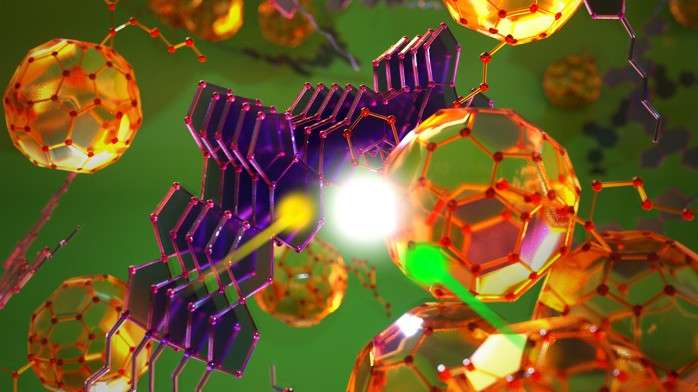Domain size and purity key to efficient organic solar cells

As solar energy becomes more popular, the drive to create more efficient, less expensive solar cells increases. Solar energy is abundant, but the devices we use to collect that energy have an efficiency problem – currently, the most efficient polymer-based solar cells operate at a shade under 11 percent efficiency.
A major reason behind this efficiency problem has to do with the structure of organic solar cells (OSC) themselves. To convert solar energy to electrical energy, charges (holes and electrons) that result from splitting excitons, the energy particles created by solar cells when they absorb light, are collected at the electrodes. A typical OSC consists of domains that arise from blending two materials – donor and acceptor – that conduct the holes and electrons respectively. The exciton travels to the interface of these domains, the exciton separates into charges, and the charges then travel to electrodes for collection.
Sounds simple enough, right?
Well, not really. Often, the exciton doesn't split because the "mix" of donor and acceptor materials isn't right. Or it splits, but the path to collection is too difficult to traverse.
Post-doctoral researcher Subhrangsu Mukherjee and physicist Harald Ade use a variety of soft X-ray techniques to study the molecular composition of solar cells. They want to understand how the solar cell's structure creates obstacles to efficient charge generation and extraction and how to overcome them. Ade's previous work found that the orientation of the donor and acceptor interfaces affect efficiency , as well as the mix between donor and acceptor layers. Recently Ade, Mukherjee, and colleagues Christopher Proctor, Guillermo Bazan and Thuc-Quyen Nguyen from University of California at Santa Barbara examined the effect of domain purity on the efficiency of solar cells that use organic small molecules in place of polymers for the donor layer.
In a solar cell, there can be clusters of each material (donor and acceptor) and regions where the materials mix. These clusters and mixed regions can vary in size. The researchers found that a high domain purity averaged over the clusters and mixed regions, coupled with the average of the size distribution of the different regions, are the key to efficient solar cells.
"The X-ray technique developed by our group enables quantification of the composition of these different phases," says Mukherjee. "Since charges separate at the interface of donor and acceptor, the importance of the mixed domains is highlighted. Essentially, the impact of the mixed domains has not been properly understood. While prior work has shown mixed domains are great for charge generation, our work has for the first time shown in a quantitative way that mixed domains can negatively impact charge collections at the electrodes by increasing charge recombination on the way to the electrodes."
The research was published in Advanced Energy Materials. Ade and Nguyen are co-corresponding authors.
More information: Subhrangsu Mukherjee et al. Solar Cells: Significance of Average Domain Purity and Mixed Domains on the Photovoltaic Performance of High-Efficiency Solution-Processed Small-Molecule BHJ Solar Cells (Adv. Energy Mater. 21/2015), Advanced Energy Materials (2015). DOI: 10.1002/aenm.201570111
Journal information: Advanced Energy Materials
Provided by North Carolina State University




















